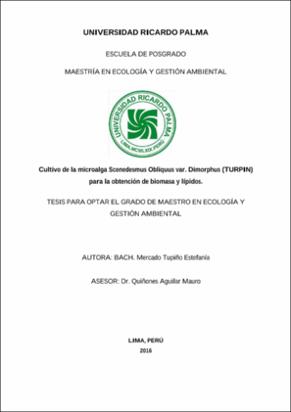| dc.contributor.advisor | Quiñones Aguilar, Mauro | |
| dc.contributor.author | Mercado Tupiño, Estefanía | |
| dc.date.accessioned | 2017-07-12T21:09:03Z | |
| dc.date.available | 2017-07-12T21:09:03Z | |
| dc.date.issued | 2016 | |
| dc.identifier.uri | https://hdl.handle.net/20.500.14138/973 | |
| dc.description | Microalgae have proved to be the Source of Energy More Economic for Production of biodiesel. In addition to reducing Carbon Dioxide, also they have a high growth rate in a short time and need less space compared to other crops.
The aim of this thesis was to determine how a culture medium for Scenedesmus obliquus var. dimorphus (Turpin) is obtained a high amount of biomass and a high oil content.
Initially, the experimental work consisted in obtaining pure strain Scenedesmus dimorphus (14 mL). Then, scaling up culture developed as follows is performed: 100 mL, 250 mL, 500 mL, 1L, 2L y 5L, to determine the growth curves by S. dimorphus cell count using the Neubauer chamber, obtaining the following results: 3 '451,500 cells in 120 hours (Bayfolan Forte), 2'472,500 cells 192 hours (BG-11) and 327,500 cells in 96 hours (Guillard). Being Forte Bayfolan that had the highest peak in increasing the population density of S. dimorphus, and in the last two culture media (BG-11 and Guillard) and in the last two culture media (BG11 and Gillard) had a high pollution what couldn´t continue grow in scale. Concluding that Bayfolan forte had better result.
After that, 5 harvest was performed, so I chose the flocculation method with aluminum sulfate Al2(SO4)3 and subsequently, for the extraction of oils, the dry biomass (36.5 g) then with solvent extraction in hexane/isopropanol, and was obtained a totally of 30 mL of lipid.
Finally, statistical part was tested using different methods, such as: Anova, Tukey and T. Student for the validity of the hypothesis. | es_ES |
| dc.description.abstract | Las microalgas han demostrado ser la fuente de energía más económica. Además, reduce el dióxido de carbono, también tienen una mayor producción en un corto tiempo y menor espacio a diferencia de otros cultivos. Entre las más de 100 especies de microalgas, el Scenedesmus dimorphus es el que tiene mayor potencial.
El objetivo de este trabajo de tesis fue determinar de qué manera con un medio de cultivo para Scenedesmus obliquus var. dimorphus (Turpin) se obtiene cantidad de biomasa y contenido de aceite.
Inicialmente, el trabajo experimental consistió en la obtención de la cepa pura de Scenedesmus dimorphus (14 mL). Seguidamente, se realizó el escalamiento de cultivo desarrollándose de la siguiente manera: 100 mL, 250 mL, 500 mL, 1L, 2L y 5L, con el fin de determinar las curvas de crecimiento mediante el conteo celular de S. dimorphus con el uso de la cámara de Neubauer, obteniendo los siguientes resultados: 3’ 451,500 unidades celulares en 120 horas (Bayfolan Forte), 2’ 472,500 unidades celulares en 192 horas (BG-11) y 327,500 unidades celulares en 96 horas (Guillard). Concluyendo que el Bayfolan Forte se obtuvo un mejor resultado.
A continuación, se realizó 5 cosechas, luego se usó el método de floculación mediante la utilización del sulfato de aluminio Al2(SO4)3 y posteriormente, para la extracción de aceites, se molió la biomasa seca (36.5 g) seguido por la extracción con disolvente en hexano/ isopropanol, y se obtuvo un total de 30 mL de lípidos.
Finalmente, en la parte estadística se comprobó la validez de las hipótesis utilizando diferentes métodos, tales como: Anova, Tukey y T. Student. | es_ES |
| dc.description.uri | Tesis | es_ES |
| dc.format | application/pdf | |
| dc.language.iso | spa | |
| dc.publisher | Universidad Ricardo Palma | es_ES |
| dc.relation | info:pe-repo/semantics/dataset | es_ES |
| dc.rights | info:eu-repo/semantics/openAccess | |
| dc.rights.uri | https://creativecommons.org/licenses/by-nc-nd/4.0/ | |
| dc.source | Universidad Ricardo Palma - URP | es_ES |
| dc.subject | microalgas | es_ES |
| dc.subject | Scenedesmus dimorphus | es_ES |
| dc.subject | Bayfolan Forte | es_ES |
| dc.subject | Guillard | es_ES |
| dc.subject | BG-11 | es_ES |
| dc.subject | hexano | es_ES |
| dc.subject | isopropanol | es_ES |
| dc.subject | agar Nutritivo | es_ES |
| dc.subject | sulfato de aluminio | es_ES |
| dc.title | Cultivo de la microalga Scenedesmus Obliquus var. Dimorphus (TURPIN) para la obtención de biomasa y lípidos. | es_ES |
| dc.type | info:eu-repo/semantics/masterThesis | |
| thesis.degree.discipline | MAESTRÍA EN ECOLOGÍA Y GESTIÓN AMBIENTAL | es_ES |
| thesis.degree.grantor | UNIVERSIDAD RICARDO PALMA . ESCUELA DE POSGRADO | es_ES |
| thesis.degree.level | Maestría | es_ES |
| thesis.degree.program | MAESTRÍA | es_ES |
| thesis.degree.name | MAESTRO EN ECOLOGÍA Y GESTIÓN AMBIENTAL | es_ES |
| dc.publisher.country | PE | es_ES |
| dc.type.version | info:eu-repo/semantics/publishedVersion | |


